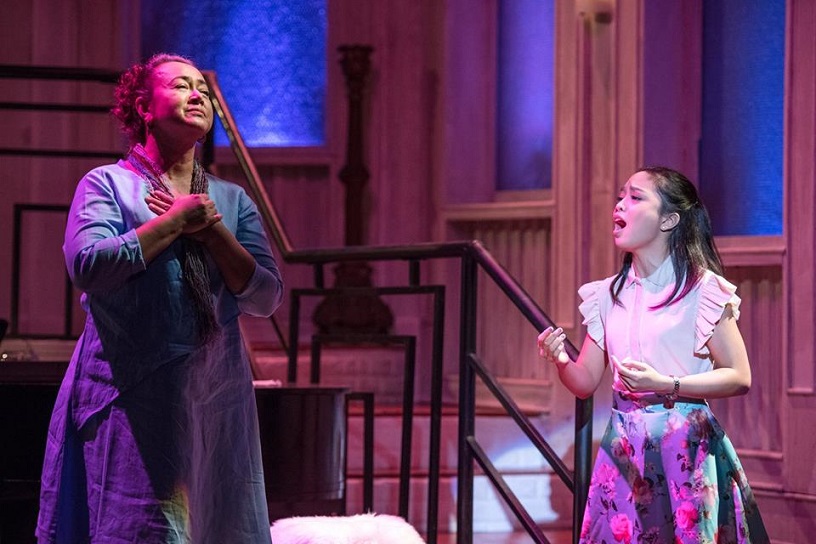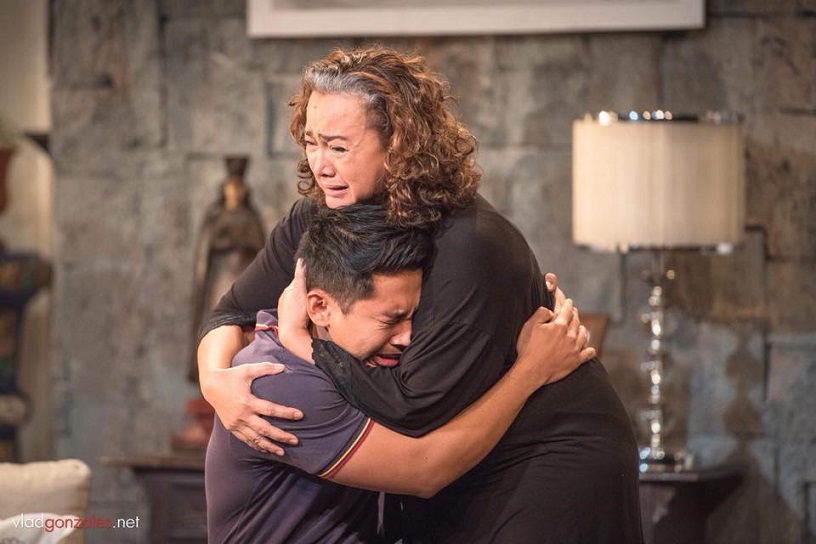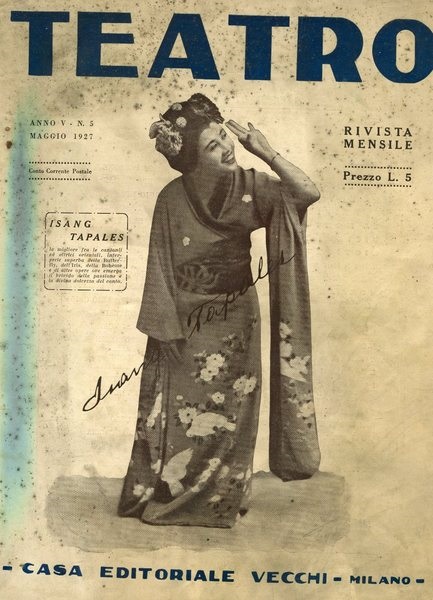There is a recurring image of the Filipino Maestra as one watched actor Shamaine Centenera Buencamino portray the role of Maestra Adela in The Kundiman Party by Floy Quintos.
The painting in the living room reminded one of the painting of Maestra Mercedes Matias Santiago as the ill-fated Lucia. She happens to the first Filipino to sing Donizetti’s Lucia di Lammermoor.
In another scene where she emerged prepared to grace a presscon for bloggers, Buencamino looked chic and resembling Maestra Dalisay Aldaba, the first Filipino to sing Madama Butterfly at the New York Opera in the late 40s.

The voice lesson scene from The Kundiman Party. Finally, a Maestra that reconnected two generations. Photo byTeetin Villanueva.
But then again hearing her holler during her voice lessons and re-emphasize the virtue of clarity in singing, she was suddenly like Maestra Isang Tapales making a point in her voice lessons with singing actor Joy Virata in her Philamlife home.
Content to live as a recluse during her last years, the character Buencamino echoed hewed close to the life of Maestra Jovita Fuentes, probably the first Filipino to sing Salome with no less than the composer, Richard Strauss, conducting her in Germany.
The typical portrait of a Maestra is one with a great career behind her and content to teach and to keep decent singing alive.
Playwright Quintos has probably observed retired divas and existing Maestras and many an operatic production enough to make a credible play on their lives.
He knows that well-wishers intone “Toi toi toi” before the curtains go up or singers wish each other in bocca al lupo (Italian for “in the mouth of the wolf”) to ward off bad spirit during the performance.
Indeed, there is enough in the Quintos play to make you remember that once upon a time in this country, great singing was taught and celebrated before the age of birit (literally reaching out for the highest note by screaming).

Shamaine Centenera Buencamino with Kalil Almonte. A gripping three-hour play with the Filipino kundiman as centerpiece.
But then Quintos has other things in mind and not just to project the image of the Maestra as great music mentor.
In the age of discontent (especially among the middle upper class), the playwright introduced the subject of social protest as it affects the artist and her sheltered milieu.
In Maestra Adela’s case, the 17-year old brother of her maid is murdered in a supposed buy-bust encounter and as she protested the killing, her pianist became another victim when unidentified men mutilated his hands as a warning.
The most memorable part of the play was when the Maestra recalled her art and life and what she sacrificed. That episode was recorded on video which ended up in YouTube getting a big number of following.
How Face Book changed their lives was the play’s life changing highlight.
The confrontation scene between The Senator (played brilliantly by Teroy de Guzman) and his son (Kalil Almonte) provided a poignant moment of truth.For the son, his cause was real, but the price was too much to pay.
As far as one could figure out, the three-hour play is the closest that a Filipino playwright could get close to highly revered opera personalities in the country.
Buencamino’s multi-layered portrayal is one of the best one has seen from this versatile actress. She has thoroughly imbibed the soul of an artist including the bravery of a woman who speaks her mind and whose vain side was ironically revealed in the age of Instagram. Her character shone as an artist and as a human being.
Almonte as Bobby Valderama captured the aura of the expert on the cyberage without losing his human qualities. His silent rage as he listened to his senator father (De Guzman) had its defining moment. His girlfriend (Miah Canton) managed to project a certain naivete as a beginner in voice lessons.
The play’s highly engaging moments came from the excellent ensemble composed of Mitch (Jenny Jamora), Mayen (Frances Makil-Ignacio), and Helen (Stella Cañete-Mendoza).

One of the country’s lastmusic mentors: Maestra Isang Tapales on the cover of a Milan magazine in the 1920s.
Equally a standout was Mitoy Sta. Ana’s production design enhanced a thousand times over by the sensitive lighting design of Monino Duque and Steven Tansiongco’s video work which showed dramatically how things go viral on the internet.
Singing as a farce was handled well by Rica Nepomuceno in Nasaan Ka Irog complete with flying scarf and handkerchiefs. She later turned dignified in her finale number Mutya ng Pasig later re-interpreted and redefined as a protest song by The Maestra.
Director Dexter Santos found the heart and soul of this play and his direction hit the mark where it should.
The play is a fitting ode to the kundiman and to the country’s Maestras most of whom have already moved on.
As it is, Quintos has reached an edifying level of maturity as a playwright. This allowed him to see the old and the new generations in an uplifting light.
His perceptions are sharp, and he spares no one including the middle upper class where he belongs.
The Kundiman Party is a beautiful requiem to the line of Maestras this country has produced through the years.
The playwright wrapped up the message of the play quite fittingly with a line fromPuccini’s Tosca —
Vissi d’arte, vissi d’amore,
non feci mai male ad anima viva!
(I lived for art, I lived for love
I never did harm to a living soul)
(By insistent public demand, The Kundiman Party by Floy Quintos and directed by Dexter Santos will have last four performance on May 12 and 13, 2018 at 2 and 7 p.m.)